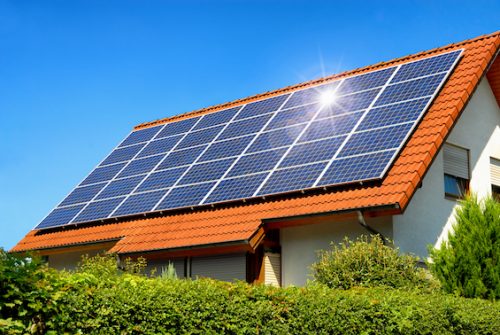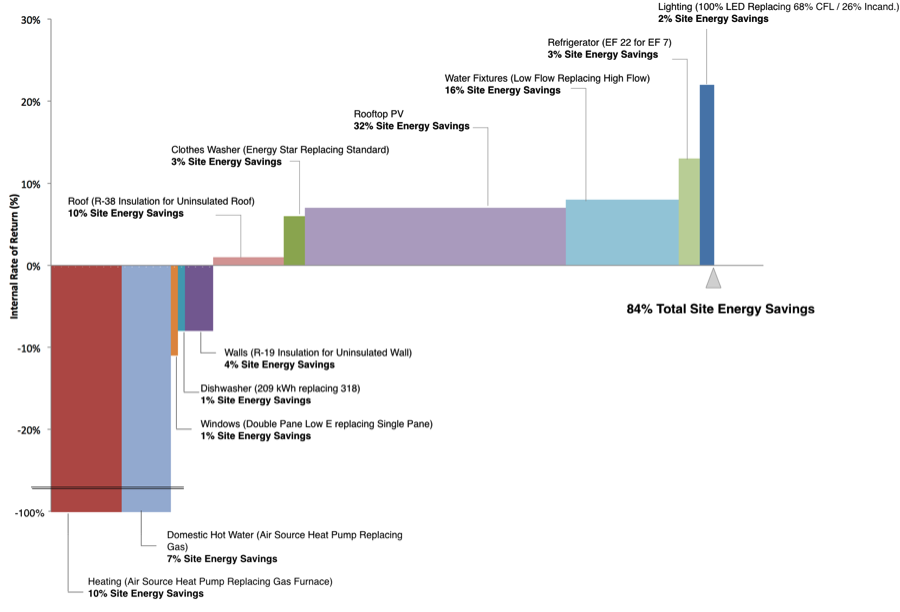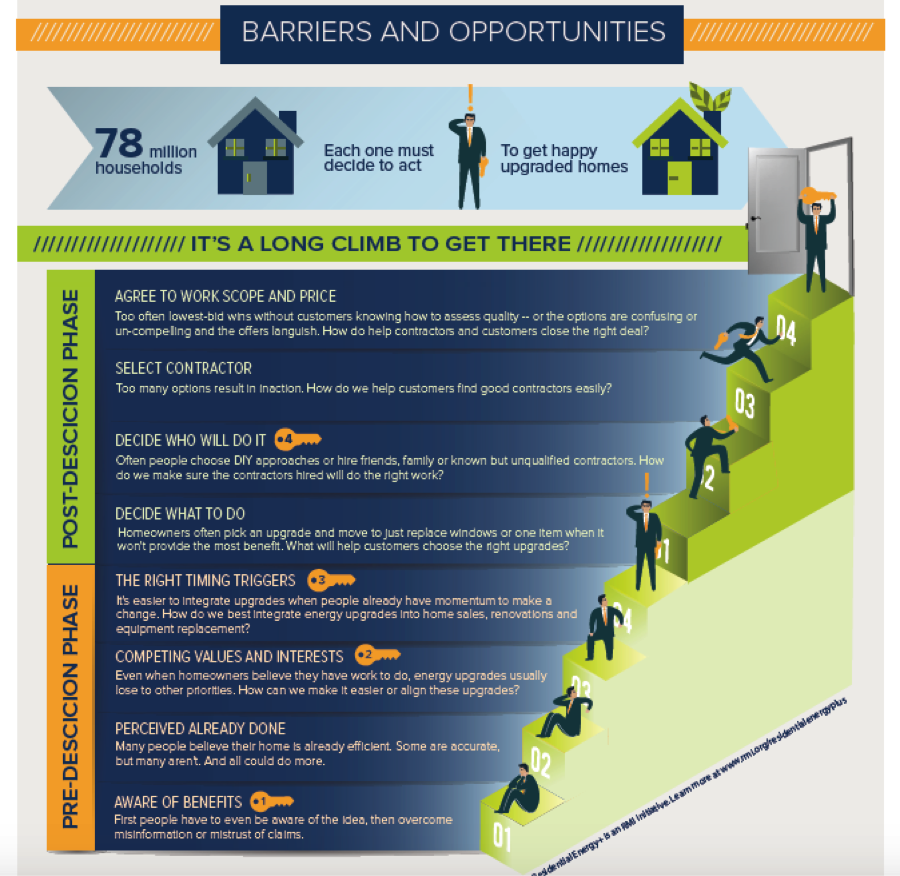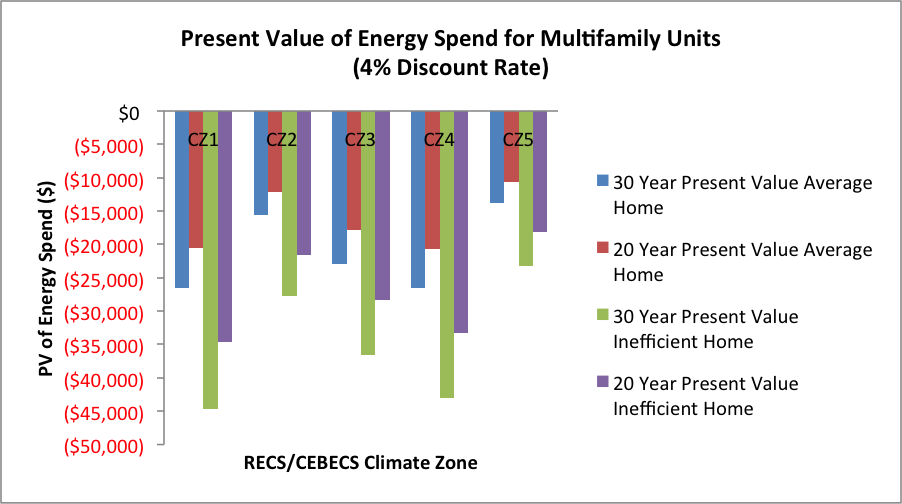Solar panel on a red roof reflecting the sun and the cloudless blue sky

Getting to Net-Zero Carbon in Multifamily Homes
Consumers wanting to undertake a deep energy retrofit of a home currently face a challenging process that involves multiple complex steps, as shown in the infographic below. For this reason, many give up on energy efficiency.
Consider what a corollary example would be with a cell phone (as RMI’s Doug Miller wrote in his blog post). Instead of simply purchasing a phone and service-provider package that you like, then selecting a contract that bills you on a monthly basis, you would have to: 1) pick which cell phone towers to route cell service through; 2) do a comprehensive analysis of the hardware required to make the smart phone “smart;” 3) secure the financing to purchase the phone; 4) fill out rebate forms and a tax form to defray some of the costs—all with different companies over a period of time. Most consumers would likely conclude, “I’ll pass.” The telecommunications industry offers an important lesson for the residential energy efficiency market: Bundle all services with financing, and target offerings to what consumers value.
RMI Senior Associate Martha Campbell, speaking at the Getting to Zero National Forum about opportunities for net-zero carbon (NZC) multifamily housing, said that existing homes need to become carbon neutral ASAP to prevent runaway climate change. The current residential building stock accounts for 20 percent of U.S. primary energy consumption. Deep energy retrofits combined with clean energy supply can get multifamily developments to net-zero carbon while also increasing comfort, safety, and affordability and providing a model to scale to the single-family market over time. Today, only a tiny fraction of homes have been retrofitted (in fact, only about three dozen homes in the U.S. have received an NZC retrofit).
A root cause of the low rate of adoption is the disaggregation of the supply and demand sides of energy, with no entity selling or demanding efficiency at scale. This means that every retrofit is a custom job, resulting in greater time, complexity, and cost. That’s where RMI’s REALIZE comes in. RMI is trying to make getting a home energy retrofit “as easy as buying a cell phone.” REALIZE—part of RMI’s Residential Energy+ initiative—aims to bring the clean industrial revolution to America’s homes by catalyzing the development of a speedy, industrialized, and scalable process for NZC residential energy retrofits.
How? REALIZE is developing a business model to bring the “Energiesprong” program from The Netherlands to the U.S. The program has facilitated more than 6,000 residential NZC retrofits, with roughly 100,000 in hard commitments, primarily in affordable housing. Energiesprong’s core offering is an NZC bundle (efficiency upgrades and on-site solar PV) that is affordable and attractive and that provides a 30-year energy performance guarantee. Plus, the retrofit can be executed in about ten days (with a goal to get it down to one week). Energiesprong does this by asking industry for a solution that meets four bold requirements: scale (very high volume); speed (construction completed in two weeks or less); self-financing (paid for via energy savings); and desirability (residents want to participate). The program is even partnering with companies like Ikea so that homeowners can update a kitchen or bathroom as they make performance improvements.
Deploying mass-customized NZC home retrofits in the U.S. is very different from deploying them in the Netherlands. U.S. customers enjoy much lower electricity rates than Dutch customers, creating a longer payback period for any home retrofit. Energiesprong focused on multifamily affordable housing nationwide, but the North American housing market is diverse and dispersed, with great regional variability in climate, construction type, housing density, vintage, building ownership models, available financing and incentives, energy and building codes, and energy costs. This variability makes it challenging to achieve the scale needed for the Energiesprong model. What’s more, the North American market is considerably larger than that of the Netherlands, creating both a large challenge and vast potential. Because of all these differences, the team spent the first phase of REALIZE asking the following questions to determine if the Energiesprong model is feasible in the U.S.:
1. What level of savings can currently be financed with 20 and 30 years of annual energy savings?
2. Which markets serve as the best entry points for this mass-customized retrofit model?
3. What is the current average cost of an NZC retrofit for different U.S. climate zones?
4. What is the difference between the current cost of an NZC retrofit and the present value of the energy savings?
RMI dove headfirst into the analysis to answer these questions, starting by supporting a partnership between the U.S. Department of Energy’s Building America program and the City of San Francisco Office of the Environment. What we found laid the foundation for our next phase of work. According to Campbell, “Climate zone 5 has the most challenging economics of any other region in the U.S. So if we can crack the nut there, we can translate best practices more swiftly into other markets.”
RMI looked at the present value of energy spend for multifamily units at a 4 percent discount rate, using the average energy spend for multifamily units, as well as the top quartile of inefficient buildings. What we found is that the most attractive economics for a ZNC retrofit exist in climate zone 1, with climate zone 4 close behind.
We put a prototypical multifamily building through the National Renewable Energy Lab’s BEopt tool, which evaluates residential building designs and identifies cost-optimal efficiency packages at various levels of whole-house energy savings along the path to NZC. We specifically looked at two retrofit “bundles”—one that optimized a housing unit’s energy savings (upgrades to walls, roof insulation, roof materials, windows, space conditioning, central water heaters, lighting, refrigerator, dishwasher, clothes washer, and hot water fixtures) with no added solar capacity, and another that included those measures as well as rooftop solar PV plus community solar necessary to get to NZC.
We found that current costs for an NZC retrofit allowed for reasonable cost compressions by industry. On a per-unit basis, a consumer today could simply pay an additional roughly $600 per year to afford an NZC retrofit. The goal still remains to compress this to $0 or better once industry is engaged to design and provide mass-produced whole-home retrofit solutions.
Figure 3: Optimal Site Energy Savings Bundle (NZC)

Notes: No incentives other than ITC and MACRs for solar. Does not account for interactive effects of measures that significantly improve measured economics. The purpose of this curve is to inform industry of where it needs to compress costs.
What’s next? RMI will continue to increase demand for deep energy retrofits and engage with industry to activate the supply-side with an eye on pilots being spearheaded by the city of San Francisco and the state of New York. Stay tuned!

